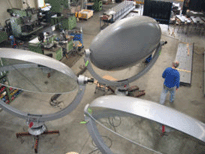

A couple of days ago I blogged about why tha kidz today would rather play video-game versions of major-league sports than watch the real ones. Then Tony Blow pointed me to a fascinating experiment in which a baseball league is blending virtual reality with actual reality.
On July 16th, the Kansas City T-Bones and the Schaumburg Flyers — teams in the Northern Independent Baseball League — will begin with two kids sitting down in front of an Xbox positioned at home plate in the CommunityAmerica Ballpark. They’ll be playing MVP Baseball 2005, and each on-screen team will have been tailored to have precisely the same stats as the real-life T-Bones and Flyers. MVP Baseball 2005 lets you create teams with whatever specs and appearance you want, so the virtual teams will not only perform like the actual T-Bones and Flyers, but the players will even look true-to-life.
The kids will play the first two innings on the Xbox. After that, the real teams will take the field — and finish up the remaining seven innings, and they’ll begin from the scores that were generated during the virtual play.
Why do this? As Knight Ridder reports:
The idea for the promotion came from the 6-year-old niece of Bryan Williams, director of community relations for the T-Bones.
“It was a fun way to get my niece involved in things I do every day,” Williams said. “Then it just grew and grew and took off.”
I love it.
UPDATE: Sadly, the commissioner of the Northern League, Mike Stone, has pulled the plug on the promotion — pointing out that outside influences on the outcome of games aren’t allowed by League rules:
“Any promotion that could affect the outcome of a regular-season game is not permissible,” Stone said. “Ultimately, such an event could have an influence on the final standings, and this certainly challenges the integrity of the league.”
(Thanks to Tony Blow for this one, and Peter Sagal for the update!)

The winners are in for this year’s annual Industrial Designers Society of America awards — and predictably, it’s a smorgasbord of incredibly cool products. As usual, my favorites are the “student” projects: Stuff that was created for a grad program and which thus does not even yet exist. One particularly cool one is the Sink Sponge by Stephen Hornbeek of the Cleveland Institute of Art, which works thusly:
The product is suctioned to the bottom of the sink, so only a single hand is needed to get glasses sparkling clean. A two hand interface is necessary for most non-commercial cleaning solutions on the market today, therefore this Sink Sponge’s single hand approach is one of a kind.
Now that’s just plain brilliant. Could some company license the design from this kid, like, now?
(Thanks to Sensory Impact for this one!)

A handful of scientists have just created the world’s first successful zombie dogs — canines that, after being dead for three hours, are brought back from the sweet hereafter. The experiment, spearheaded by Dr. Patrick Kochanek, works like this: The scientists drain the dogs of all blood, and replace it with saline solution chilled to a few degrees above zero. The temperature of the dogs’ bodies drops to 7 degrees celsius; they die of hypothermia first, and when the transfusion is complete, the cold saline preserves their organs from decay.
To bring them back to life, the scientists return the blood to their bodies, surround them with an atmosphere of 100 per cent oxygen, and — in a detail that couldn’t be more Frankensteinian — use electric shocks to restart their hearts.
The research is quite important, because the scientists eventually hope to create techniques allowing critically-ill patients — such as battlefield soldiers — to be preserved in a safe state of suspended animation for hours while being transported to a suitable hospital. But let’s face it: The mere details of these experiments are so inherently ghoulish that animal-rights advocates were pretty much guaranteed to object, as the New York Post reports:
Mary Beth Sweetland, a spokeswoman for People for the Ethical Treatment of Animals, said: “These experiments are indefensible nonsense and the results for humans will be negligible. I would also imagine there are serious consequences for these animals that aren’t discussed.”
Woof. It probably doesn’t help that Kochanek’s research group is called the Safar Center for Resuscitation Research — a name with positively comic-book qualities — or that games like Resident Evil have long included killer zombie dogs.
This is intriguing: Apparently, Francis Crick was on LSD when he conceived of the double-helix shape of DNA. A story in the Sunday Mail reports on Dick Kemp, a British biochemist who in the early 50s experimented with synthesizing TCH and hallucinogens such as LSD. One of the Kemp’s friends, Garrod Harker, told the Mail reporter about a fascinating conversation the two once had:
“Dick Kemp told me he met Francis Crick at Cambridge. Crick had told him that some Cambridge academics used LSD in tiny amounts as a thinking tool, to liberate them from preconceptions and let their genius wander freely to new ideas. Crick told him he had perceived the double-helix shape while on LSD. [snip]
“Shortly after, I visited Crick at his home, Golden Helix, in Cambridge. He listened with rapt, amused attention to what I told him about the role of LSD in his Nobel Prize-winning discovery. He gave no intimation of surprise. When I had finished, he said: ‘Print a word of it and I’ll sue.’”
This may not be as surprising as antidrug conservatives might imagine. Cutting-edge scientists have a long history of using themselves as guinea pigs to determine the effects of new chemicals; they’re also intrigued by anything that can help them think better. Put the two together, and I’d imagine a pretty large number have tried LSD and Ecstasy, which are renowned for producing philosophically unique states of mind.

On July 4, NASA’s “Deep Impact” probe will perform an intriguing experiment with Comet Tempel 1: It will hurl a 820-pound weight into the surface of the comet, then stand back and observe what weird stuff comes flying off the surface. Cool enough, but what I particularly like is that NASA is following its recent trend of creating incredibly cool animations for its space missions. It’s put a little movie online illustrating what the Deep Impact smashfest would look like if you were out there in space watching it. As they note:
The resulting collision between comet and impactor will likely punch a crater, anywhere from the size of a Sport Utility Vehicle to a football stadium, into the comet’s nucleus. Before, during and after impact, the flyby spacecraft wil be observing events from a safe distance, imaging the crater formation and resulting ejecta.
The video has a gorgeously eerie beauty: The backlighting on the comet and the ejecta creates a creepy sense of isolation and distance — you really feel like you’re floating millions of miles out in space, with the sun only a distance influence.
It makes me wish that NASA would produce some video games using this aesthetic. Imagine a little game where you could fly the mission in different ways: Increasing or decreasing the mass of the impact-weight, speeding up the pace at which it hits the comet, or tweaking its angle. Then you could record whatever cool stuff happens as a little video to post online. It’d be like The Sims, except with astrophysics!
(Thanks to Slashdot for this one!)

Various SETI efforts — the Search for Extraterrestrial Intelligence inside our galaxy, bien sur — have been ongoing for thirty years, with no success yet. If there’s intelligent life out there, we haven’t been able to detect it with our arrays of radio telescopes and funky parallel-processing screensavers.
But what if we’re simply looking in the wrong place? SETI projects tend to look for intelligent civilizations near stars, under the assumption that those energy sources are crucial to life. But in an interesting new paper (of which the PDF is here), the astronomers Milan M. Circovic and Robert J. Bradbury argue that any long-lasting intelligent civilizations will have intensive information-processing needs, and indeed may “be” information, having hit the Singularity and uploaded their consciousnesses into the aether. In that case, the authors suggest, alien civilizations would head out to the frozen outer regions of the Milky Way — where information-processing would be easier for thermodynamic reasons.
As far as I can make it out, the argument goes like this: Any computer, in the act of doing computation, generates heat and needs to be cooled down with a heat reservoir. Obviously, a civilization composed of information will be doing a monster truckload of computation. Thus, as the authors argue:
In the ideal case, no energy should be expended on cooling the computer itself, since that expense should be added to the energy cost … The most efficient heat reservoir is the universe itself, which far from local energy sources like stars and galaxies, has the temperature of the cosmic microwave background. [Italics in original]
If they’re right, we need to radically rethink our SETI strategy.
Heh. I love that sentence. “We need to radically rethink our SETI strategy.” I think I just won some sort of Blog Pompousness Award.
(Thanks to Robots.net for this one!)

Plenty of pundits have inveighed against the increasing idiocy of basketball these days — because the players’ naked desperation to become the next slam-dunking superstar leads everyone to hog the ball, never pass, and thus destroy any possibility of the team functioning as, well, a team. Michael Sokolove wrote a terrific analysis of this in the New York Times Magazine a few months ago.
If you wanted more — and weirder — evidence of the NBA’s malaise, read a story on the cover of the Times itself today, in which Seth Schiesel reports on the fact that many young kids and teenagers think the video-game versions of the NBA and the NFL are more interesting than the real-life ones. They’d rather play those games than watch one on TV. And why not? In addition to being able to participate, they can actually play the game as it’s supposed to be played — with teamwork. As one teenager points out:
“I like Kobe, O.K.?,” Albert Arce said, referring to Kobe Bryant, the Los Angeles Lakers star. “But I like to play him because I can make him pass to the other guys. When I see him on TV, it’s like he doesn’t know how to pass.”
Perfect. Personally, I think we should just skip the inevitable transition point here, and emulate South Korea: Instead of televising actual real-life games, let’s simply broadcast video-game matches. I’d far rather watch a couple of skilful teenagers try to outsmart each other on the virtual court — using actual wits, strategy and timing — than watch the dreary cavalcade of freakshow eugenics that pro sports has become.
While we’re at it, hell, why not completely halt all broadcasting of anything remotely related to actual, real-life sports? Put deathmatches of the world’s top-ranked Halo, Counterstrike, and Unreal teams on prime-time TV. Then we’d actually have something worth watching!

As you may have heard, the L.A. Times recently got enamored of wikis — those web sites where anyone can add, edit or delete text. So they launched a “wikitorial” section, which would publish op-ed pieces that readers could edit if they disagreed with the opinions. Tragedy struck: A mere two days after the section launched, the Times was forced to pull the entire section offline after users posted “inappropriate images” — including hardcore porn and the infamous image from goatse.cx (a massively prolapsed anus, which is precisely as revolting as it sounds).
What went wrong? After all, the inspiration here was Wikipedia, a user-generated wiki that has become the world’s largest, fastest-growing, and entirely free encyclopedia. Well, one obvious difference between Wikipedia and the wikitorials — as pundits like Jeff Jarvis have noted — is that wikis are designed to transmit hard, factual information, the content of which reasonable people can more or less agree upon. This isn’t the way opinion pieces work at all; the audience isn’t supposed to generally agree upon the content. It’s remarkable that the Times editors didn’t grok this basic fact, and put a halt to the entire ridiculous experiment before it even got started.
The irony is that the Times shouldn’t have been using wikis to gather opinions. It should have using them to gather facts. And this is where things get really interesting — because understood correctly, wikis ought to be an inspiration to American media and political culture.
Why? Because these days, many American journalists and politicians behave as though factual reality doesn’t exist. On the right, guys like Bill O’Reilly brazenly distort the news to support their arguments; on the left, pundits like Michael Moore play pretty fast and loose with reality themselves. The Bush administration reportedly regards itself as exempt from the “reality-based community” — that flourescently Orwellian phrase a senior Bush aide used to dismiss those who respect the idea of accurate facts. The biggest problem in political life right now is not differences of opinion — it’s that people believe entirely different versions of reality. The Bush government claims that no one has been tortured at Guantanamo Bay, that tax cuts have not caused much deficit damage, and that the Iraq insurgency is in its “last throes”. Critics say precisely the opposite is true.
This is what’s so singuarly refreshing about wikis: They prove that diverse people — many of whom hate each other’s guts — can actually agree on basic facts. Indeed, to post to Wikipedia, you must agree to behave in a way totally foreign to Washington and attack-dog media, and write in a “neutral point of view”. To make it clear precisely what neutrality means, Wikipedia founder Jim Wales has written a first-rate discussion of his philosophy:
Unbiased writing presents conflicting views without asserting them. Unbiased writing does not present only the most popular view; it does not assert the most popular view is correct after presenting all views; it does not assert that some sort of intermediate view among the different views is the correct one. [snip]
The prevailing Wikipedia understanding is that the neutral point of view is not a point of view at all; according to our understanding, when one writes neutrally, one is very careful not to state (or imply or insinuate or subtly massage the reader into believing) that any particular view at all is correct.
Another point bears elaboration as well. Writing unbiasedly can be conceived very well as representing disputes, characterizing them, rather than engaging in them. One can think of unbiased writing as the cold, fair, analytical description of debates. Of course, one might well doubt that this can be done at all without somehow subtly implying or insinuating that one position is correct. But experienced academics, polemical writers, and rhetoricians are well-attuned to bias, both their own and others’, so that they can usually spot a description of a debate that tends to favor one side. If they so choose, with some creativity, they can usually remove that bias.
Go read this essay in full; it’s a remarkable document. Wales’ commitment to neutrality is so smart and principled that it feels otherworldly — like some mathematically inverse image of our real-life Bizarro planet of square-tired pundit logic and Washingtonian mendacity.
Granted, Wikipedia’s pursuit of neutrality sometimes fails; during the last presidential election, Wales was forced to “freeze” the entries on George W. Bush and John Kerry, because they were being so regularly defaced. But in general, Wikipedia stands as a cultural beacon, proving not only that an impartial presentation of facts is possible — but that the public wants it, and is willing to help work on it.

Which are happier: Male cyborgs, or female ones? In today’s New York Times, there’s an excellent piece by Michael Marriott on how robotic prosthetics are evolving — and how people’s attitudes towards them are changing, too. In the past, as he points out, prosthetics were regarded as creepy and uncanny; those with artificial limbs tended to keep them hidden so as not to freak out everybody around them. But as pop culture has grown more obsessed with kewl gadgets and cyborg superheros, the idea of having technology visibly integrated with your flesh has recently become much more acceptable — and even kinda cool. As Marriott writes:
Increasingly, amputees, especially young men like Mr. Clapp, and soldiers who have lost limbs in Afghanistan and Iraq, are choosing not to hide their prosthetics under clothing as previous generations did. Instead, some of the estimated 1.2 million amputees in the United States proudly polish and decorate their electronic limbs for all to see.
Marriott interviews one young guy who thinks nothing of plugging his legs into a wall-socket to recharge while he enjoys a few beers at a party. Yet when it comes to women and their robot limbs, things are much cloudier:
Hope Harrison, a professor of history and international affairs at George Washington University in Washington, had a leg amputated in 1979. Ms. Hope, 43, said she had used a range of prosthetics, but preferred the C-Leg now. She also prefers to wear it with a natural-looking cover.
“It’s one thing to see a man with a Terminator leg,” Ms. Harrison said, referring to the cybernetic character played by Arnold Schwarzenegger in the blockbuster movie series. “It may inspire people to say, ‘Cool.’ But body image for women in this country is model thin and long sexy legs.”
Well, there you go: Even after decades of sci-fi novels featuring airbrushed pictures of female robots with big tits, it seems that the cyborg aesthetic doesn’t extend quite as easily to women. This is an interesting enough observation for amputees, who are essential forced to use artificial appendages. But what happens when people start choosing to upgrade their arms and legs with better robot parts? What will the gender politics be for voluntary cyborgs? Perhaps we’ll see the same double standard: It’ll be socially acceptable, and even desirable, for guys to sport lots of chrome — while women who do so will be regarded as overly butch or subculturally weird.
Then again, maybe not. A decade ago, tattooes were primarily acceptable only on men, too — until an explosion of ankle butterflies and lower-back rose-thorn cornices made the female tattoo about as socially transgressive as the minivan.

Are big-screen televisions the new SUVs? Researchers at National Resources Defense Council, an environmental group, recently conducted a fascinating experiment: They ran a two-minute clip of Shrek on a whole range of TVs, from small analog ones to massive, table-top-sized high-definition sets, while measuring the power usage. The result? The new big boys chew more than twice the energy of the old-school TVs — check out the chart above. Interestingly, high-definition images require more power for their increased picture quality.
While energy-efficiency technology certainly does exist that could reduce the power-suck on these new sets, electronics companies aren’t building it in yet. That’s a big problem because, as the Christian Science Monitor reports:
“The price of these big-screen TVs is coming down, so more and more people will soon be able to afford them,” says Noah Horowitz, a senior NRDC scientist. “If we do nothing, it will lock-in power consumption at higher levels. People keep a TV five to 15 years, so we really need to get started making them as efficient as they can be.”
Already, TVs account for four per cent of energy usage in the home, and the NRDC figures that’ll increase by 50% in the next four years, as everyone buys new, ginormous sets. I gotta admit, having wandered by Circuit City to check out the latest plasma monsters, I already crave one. And I don’t even watch TV! I just want it as an output device for my game consoles.
(Thanks to Techdirt for this one!)


This is great: The Dutch design firm OOOMS has created “City Hideout”, a collapsable metal enclosure that you can quickly erect and squat inside — and thus disappear in plain sight, since it looks like a nondescript piece of urban infrastructure. Indeed, it looks almost precisely like the little ventilated boxes that New York uses to shelter electrical equipment at street level. And as the Coolhunting blog notes …
The most intriguing feature of this seemingly simple structure is the stark duality inherent in the design. When viewed as a form of escape and asylum from the city, a shelter from metropolitan neurosis, the hideout exudes an OK Computer-like charm, allowing its owner an opportunity to innocuously disappear amidst the bustle he can no longer handle. At the same time, the hideout’s slits create the perfect condition for a new breed of urban voyeurism, suddenly casting its inhabitant as a pathological threat to all passers-by.
Check out the link — there are a few really hilarious images of the Hideout in action.
(Thanks to Debbie for this one!)

Over in the UK, a poker site named PartyGaming is about to go public. No big shock there — except that if the company hits its expected first-day price, it will instantly be worth $10 billion, slightly less than Marks and Spencer, and more than British Airways and EMI put together. Why? Because in the last three years, its pretax profits have risen from from $5.8 million to $372 million, and it’s currently pulling in about $58,000 an hour. The business plan is simple: It lets people play poker together online, and shaves a tiny 1% off of each pot.
The company was founded by a woman who’d made her fortune in online porn, who hired a 25-year-old kid fresh out of an Indian comp-sci program to write her software. That’s surreal enough, but my favorite detail about the company, as reported in The Guardian, is this:
PartyGaming’s head office is in Gibraltar; its computer servers run from there and from Kahnawake, a Mohawk Indian reserve within Canada; its marketing office is in London but most of its 1,000 staff work in a call centre and software development site in Hyderabad, southern India.
Man alive. Porn, call-service-centers, Canadian Indian reserves — it’s like the wireframe model for a sci-fi novel cowritten by Cory Doctorow and Thomas Friedman.
As an unrelated aside, I wonder whether the rise of poker is a permanent new fixture in global culture, or a short-term bubble. I don’t actually play poker, and I don’t find it interesting to watch. But ludologically, I’m fascinated by the ascendance of games in today’s pop culture — a category that, judging by the popularity of poker, goes quite beyond videogames, and now includes competitive reality TV. Skill-based games have always been huge, of course; pro sports have been around for centuries. But the skills celebrated in today’s newly rising games aren’t about physical achievement so much as more about cunning, bluffing, and Victorian subterfuge — it’s like a world gladiatorial culture designed by Jane Austen.
(Thanks to F!LTER magazine for this one!)

In New York right now, it’s insanely hot, so I’ve been out shopping for air conditioners. I was thus tickled to read about the ultimate low-tech cooling unit, created by a Canadian engineering student who was too broke to pay for an A/C. For $30, he wrapped a regular fan with copper tubing, then filled a garbage can with water and ice. He pumped the water through the tubing, using gravity as a free source of energy. Presto — it cooled the room for up to three hours per filling, as he describes on his site:
If you look closely, you can see the condensation from the incoming icewater, but no condensation on the tubing leading out. This is perfect, as it means that heat is being transferred from the room to the water.
I love low-fi hacks like this.!
(Thanks to Boing Boing for this one!)

In the current issue of Wired magazine, I published a profile of William Hurlbut — a Stanford physician who is developing some intriguing ways to rethink what makes humans humans, in the age of biotechnology. Specifically, he has authored a proposal for a way to ethically farm stem cells, by creating embryo-like entities that would never be able to become full humans — and thus would not, according to religious doctrine, possess souls.
If you’re interested, you can read the whole story for free at Wired’s site, including some great photos; better yet, go buy a print copy! (The issue also has a superb piece on how unmanned drones are changing the culture of the military, by my friend Noah Robischon.) I’ve also archived my piece below, so here it is:
How to Farm Stem Cells Without Losing Your Soul
A solution to the stem cell dilemma that even the Vatican can love.
By Clive ThompsonWilliam Hurlbut clicks his laptop, and an x-ray pops up on the projection screen behind him. It’s a picture of a tumor in a woman’s ovary — a ghostly blob floating near the spine. In the middle are several strange, Chiclet-shaped nodules. “Those white opacities,” Hurlbut says, “are actually fully formed teeth.”
A few audience members blanch. Though we’re in an ordinary conference room in Rome, it feels like church. The seats are filled with some of the Vatican’s top thinkers, including a dozen men in clerical dress, a nun in a flowing brown habit, and a Dominican priest whose prayer beads quietly clatter. Hurlbut, a bioethicist from Stanford, has traveled here to tell them about a new way to create human embryonic stem cells.

Back in March, I blogged about the discovery of the first bipedal octopus — a cephalopod that tucked six of its legs up into a ball and walked on its remaining two like a human, apparently to psych out its predators. Apparently one of the discoverers was Bob Full, a roboticist famous for studying the gaits of everything from cockroaches to humans, in an attempt to perfect robotic walking.
Now, according to a story in the BBC, the bipedal octopi are inspiring Full to examine the idea of using stretchy octopus arms as a paradigm for robotics. The octobot would have no rigid form at all — it’d be a series of connected artificial muscles that can expand or contract in unison. Thus, it could perform some of the classic tricks of our invertebrate friends:
With no hard parts, the creature can squeeze through tiny spaces.
“That’s the advantage of soft robotics,” he added.
“Can you imagine how wonderful it would be to function as a search and rescue robot, to be able to go into areas - after an earthquake, after a car accident, during a fire - and move into spaces that no other robot could get into.”
To recap: The first hydrostatically bipedal octopus ever discovered is now inspiring the design of cephalopodic robotics. Man, I can now die happy after having written that sentence.
(Thanks to John T. Unger for this one! I also totally stole the title to this entry from Grist Magazine.)

This is pretty awesome: Jacques Rougerie, a French designer, has drawn up plans for the SeaOrbiter, an enormous marine-science platform that would float like an iceberg — with much of the action happening under the water. As CNET reports:
Drawings show eight central work levels occupying about half the height, and a RedNova news story puts it at 165 feet. Windows on the lower levels are meant to let marine researchers spy on whales and other hard-to-observe creatures; it’s hoped that the minimal use of an electric engine will help keep from scaring the sea life away. Underwater sections could also be used for training by astronauts; SeaOrbiter’s supporters, who include the Mercury astronaut and underwater enthusiast Scott Carpenter.
It’ll never get built, of course. But what I particularly love is how the design harkens back to the sci-fi of the 50s — when the future had gorgeously modernist industrial design. I mean, look at the crazy circular discs protrubing from that thing! Sure, maybe they have some structural purpose related to stabilizing the platform … but I bet they’re in there just ‘cause they look totally awesome. As my friend Morgan pointed out in his commentary on the SeaOrbiter, “I would like to suggest to the folks who designed this (and hope to build it) that future pitch images should include people flying from level to level using personal jetpacks.”
Interestingly, the designer Rougerie has a web site with more sketches of possible marine vehicles, many of which seem have been biomimetically designed off of jellyfish and squid. This guy is steel.
(Thanks to Morgan for this one!)

Hey, fellow citizens: Sick and tired of hearing right-wing politicians babble on about “family values”, the evils of nuisance rights like “privacy”, and the inherent decency of life in the midstate exurbs? Then hie thee to today’s Science section of the New York Times, for an amazing Q&A with Stephanie Coontz, a professor of family studies at Evergreen State College, and author of the recently-released Marriage, a History (pictured above). There’s nothing like the cold gaze of factual research to expose the ridiculous fantasies spun by conservative politicians about how great life was for women back when they were uneducated, stuck in the kitchen, and financially dependent on men who neither trusted nor respected them.
As Coontz points out, the ubernuclear families in days of yore weren’t fuzzy, warm nests of love: They were primarily all aboout setting up a blood line to maintain your property and resolve fueds between families — essentially, a medieval mergers-and-acquisitions department. Anyway, things really kick in to high gear when she tackles the hypocrises of the right, which currently bestride our country like a colossus:
Q. What do you make of the fact that divorce rates are especially high in many “red” states like Oklahoma and Alabama?
A. I see it as a sign that families are changing so rapidly that stated values are poor predictors of actual behavior. Educated individuals are more likely to have a value system that says it’s O.K. to be divorced, but they are less likely to do it. Blacks are more likely to disapprove of cohabitation than whites, but much more likely to cohabit. Oklahoma and Alabama have high divorce rates. Massachusetts, the poster state for liberalism, does not.
Q. Magazines sometimes run articles on female tycoons who quit to become soccer moms. What are those articles really about?
A. Wishful thinking, I suspect. The trend measurements don’t show that’s happening. What they show is that the rapid influx of mothers with young children into the workplace has leveled off and fallen, slightly. In 1998, almost 60 percent of women were returning to work before their kids were 1. Now it’s 55 percent. This may be a sign of the revolution consolidating rather than reversing itself. Many women now have the confidence to say, “I can negotiate longer leaves, and if I can’t, I’ll quit and find something else later.”
“Stated values are are poor predictors of actual behavior.” I love it.
Last month, I blogged about the ways in which new media change our ideas of beauty — by changing the thing the camera “sees”. People with sharp facial features looked great in black-and-white movies, but lost ground when color came in, a format that rewarded softer features. Then I started wondering about high-definition TV, which can pick out the tiniest facial flaws swith unforgiving precision. What effect was that having?
So I started researching it, and wrote a short essay for this week’s New York Times Magazine. You can read it online at the site for free, and for posterity’s sake, a copy is below:
Not Ready for Their Close-Up
by Clive ThompsonCap Lesesne, a New York plastic surgeon, hears from a lot of women worried about aging. Late last year, he says, he had one visitor, a female newscaster, whose inquiries puzzled him. She was only in her 30’s, he says, and still looked terrific. (Lesesne, citing doctor-patient confidentiality, wouldn’t identify the woman.) When he asked her why she wanted surgery, she explained that her show was about to begin broadcasting in “high-definition,” the hot new digital technology that makes TV images look as crisp and sharp as IMAX films. On normal TV, she said, you can’t see her few tiny wrinkles; in high-def, they stand out like folds of origami. “When she walked in here,” Lesesne says, ” ‘high-def’ was the first thing that came out of her mouth.”

Two weeks ago, Danica Patrick made history by being the first female driver in the Indy 500 to come in fourth — and to lead the race for a significant number of laps. It wasn’t a fluke: Patrick’s a rookie, but she’d recently been posting record speeds. However, since racing is not merely a guy sport but — since it involves ultrafast cars — a particularly testosterone-soaked guy sport, the checkered flag had barely finished waving before Patrick’s losing competitors began complaining that she’d had an unfair advantage.
Why? Because she only weighs 100 pounds — which means that her car is lighter than all her male competitors, who weigh significantly more. The winner of the Indy 500, Tony Kanaan, weighs almost 50 pounds more. The Indy 500 rules require that each car weigh at least 1,525 pounds, but that’s without the driver inside, and the drivers have no weight restrictions at all. Thus, a smaller driver like Patrick can arguably move faster and conserve more gas. As one competitor calculated, her lighter weight could give her an edge of 0.8 of a mile in an hour.
But the biggest complaints came from racer Robby Gordon:
“The lighter the car, the faster it goes,” Gordon said. “Do the math. Put her in the car at her weight, then put me or Tony Stewart in the car at 200 pounds and our car is at least 100 pounds heavier. I won’t race against her until the IRL does something to take that advantage away.”
It’s a fascinating moment. In virtually every other major, highly-televised sport, the opposite logic obtains — and athletes have been rewarded for being more and more freakishly huge. The NBA is, for all intents and purposes, no longer a sport but a sort of intriguing genetic contest to see which team can acquire the most ludicrously enormous giant. Hell, even baseball is being infected with this disease, and there’s really no point talking about football, which has long degenerated into nothing more than two teams slingshotting refrigerators into one another across an empty field. What in god’s name does this have to do with actual striving, competition, skill — and, well, sport? Major league games have basically been reduced to mere physics experiments, with essentially predetermined results: Calculate the mass, calculate the velocity, there’s your result.
Danica Patrick freaks many people out because the idea of someone excelling at a sport because they’re smaller is so very, very freaky. It violates our idea of what a winner ought to look like. We don’t merely want someone to excel — we want winners to be a certain type: A grotesquely goliath victor prancing through the end-zone with the sort of mincing, self-glorying idiocy of today’s top major-league figures.
Holy god am I letting my geek flag fly here today. Can you tell who was the nerd that hated gym class?

You know, when you visit the web site of something as impossibly dull as “The AMA Compensation Survey of Marketing Professionals”, you figure it’s gonna be boring, right?
Nope. That web site has the creepiest, eeriest visuals I have ever seen in over a decade on the Internet. I am so totally not exaggerating. The picture above is a hint, but I won’t describe what you’ll see — I don’t want to give away the surprise. Suffice to say that I had the same reaction as the guy who pointed this site out to me, who told me that “I almost screamed like a little girl.”
(Thanks to Ian for this one!)

I had never head of Blogebrity, a blog devoted to the “celebrity” culture of blogs. That sounds waaaay too navel-gazing and meta for words, but since the whole project seems pretty tongue-in-cheek, I’m assuming the creators are doing it with a wink and a nod. The thing is, using some metric — I’m not sure which — they’ve created an “A List” of the most important bloggers, such as Andrew Sullivan, Clay Shirky and Ana Marie Cox. It’s sort of interesting reading the list, since it’s a combination of people who are famous for blogging, and people who were already famous and then decided to blog — which shows that the old media ain’t dead yet.
The Blogebrity folks also created “B” and “C” lists of less and less famous bloggers, and the whole reason I heard about the site is that this morning a friend discovered that I myself appear on the “C” list.
Does this mean I get to hang out with Tara Reid and shit?
UPDATE: I’ve just been informed that Blogebrity is not actually a real site, but a concoction designed to win the Contagious Media award. In which case I actually think it’s clever as hell!
(Thanks to Maura for this one!)

Artificial-life sims have always been lots of fun, except for one problem: For decades, the “life forms” have only existed on the computer screen, so they’ve never seemed very real. This all started to change with the Internet and video games, where the action of real life itself takes place — bien sur — on the screen. When you’re an avatar in a virtual world, the line between who’s “real” and who’s “artificial” is much easier to blur.
A brilliant example of this is the work of Surina Skallagrimson, a resident of Second Life, the increasingly-popular 3D immersive game-world. Second Life has a simple scripting language that allows users to create their own in-game stuff; recently, Skallagrimson decided to create a school of fish. She wrote a script to govern the behavior of an individual fish, then made hundreds of copies with slightly different attributes: Some could swim fast, others could see farther, and so on. Then she turned the fish loose in Second Life’s ocean to see what they’d do. Most of ‘em just wandered around aimlessly, so she killed them off; the few that seemed to behave more purposefully, she kept.
She did this a few hundred times and, in essence, created her own little evolutionary hothouse — such that she now has a school of fish that behaves very, uh, fishlike. (Fishy?) Anyway, Wagner James Au — the writer who pens a brilliant blog reporting on the goings-on inside the world of Second Life — recently met up with her at the bottom of the ocean, where she showed off her school. As Au notes:
The gold standard for any creator of artificial life is unplanned emergent behavior, and Surina has noticed at least a couple instances of these. For one, with enough fish in the school, they begin to move in circles. “[T]hey tend to form a line. And if the front moves around so it ‘sees’ the back of the line, they circle.” With the addition of food, she’s also noticed that “the weaker ones tend to lead the shoal. They are the ones most in need of food. The ones most in need of food will tend to break away from the shoal. This causes the rest of the shoal to follow, so you end up with the weakest near the front, heading for food.”
(Thanks to W. James Au for this one!)

When you go to a park, the whole point is to sit on the grass and bask in the lovely sunshine, right? Unless you’re in New York — where the enormous buildings impose a canyonlike gloom over many areas. So it was with the designers of Teardrop Park South, down in the Battery Park area of New York: They began extending their park at the same time as a new building was being erected, and realized they were about to face a huge problem. When both projects were completed, the building would permanently shield the park from the sun. What to do?
Haul in some huge-ass mirrors and manually re-route sunbeams, that’s what! Apparently, David Norris — a “sunlight consultant,” a job title that has simply got to look suave on a business card — stepped in to save the park, by designing a trio of eight-foot-tall mirrors that will be installed on nearby roofs and controlled by computers. As the Tribeca Trib reports:
The mirrors … will reflect enough of the sun’s rays to keep the park in sunlight year-round, he said, and in some ways will be more effective than broad daylight since the rays can be directed to different spots at different times of the day or season, as needed. The light will shine in large pools or in well-defined spotlights, but will not be concentrated enough to blind or burn, he said. “It’s nothing more than once-reflected sunlight, somewhere on the order of 70 to 80 percent of the power,” he said.
Heh. I love the fact that they had to clarify that the mirrors would not be used to fry passersby like tiny ants.
Seriously, though, I wonder — has anyone ever used this technique in other ways, such as to direct sunlight deep inside buildings that have many internal rooms with no windows? Every time I visit a friend who works at a major newspaper, I’m amazed: Those places are like mushroom farms, they’re so dark and unlit. Similarly, I once thought it’d be fun to put a webcam on the roof of my apartment building, pointed at the sky, and route the picture down to my computer as its desktop image. It would, in effect, be just like the old Windows “blue sky” desktop picture, except the clouds in the sky would actually move, and occasionally it would rain.
(Thanks to Sean for this one!)

Jason Uechi, who programmed the insanely cool application “red | blue” — which lets you use a GPS-enabled phone to detect who nearby you is donating to which political party — has come out with another excellent app: Shrunq. It’s a web browser for mobile phones, and it solves some of the usability problems that currently plague most phone browsers.
For example, most browsers “chunk” text up — breaking each page into dozens of tiny subpages, which turns reading short documents into a huge hassle. Shrunq, in contrast, doesn’t chunk: It gives you the whole page at once, or as much of it as will fit in your phone’s memory.
But Shrunq has tons more neat features, incuding my favorite:
Another feature to quiet my chunkaphobia is a feature I’ve awkwardly called “Skip To Content” — which is a simple action that jumps you down the page to “meaningful” blocks of text. What do I mean by “meaningful”? Often at the start of a web page there are many short links and blurbs for navigation, so this feature analyzes content as it streams in, and identifies longer lines of text. Any click on “Skip to Content” jumps you down to the next spot with a longer line of text — usually more “meaningful” content.
That’s tres smart. Perhaps more awesome yet is the fact that when Jason gives examples of several web pages as seen through Shrunq, one of them is Collision Detection — as pictured above. Woo!

Last year, board-game designers Greg Stolze and Daniel Solis decided to create a title called Meatbot Massacre — a tongue-in-cheek, dice-rolling bit of tactical play. Since the board-game industry has notoriously tiny profit margins, they realized that they could make a lot more money — and produce a much less expensive game — by distributing it online as a downloadable PDF instead of trying to go the traditional route, publishing it in a box to sell at stores.
The problem was piracy. If you publish your game as a PDF, it’s really easy for people to simply pass it around without paying you a dime. What to do?
Re-engineer the entire concept of publication, that’s what! Last December, Stolze and Holis invented what they call “the ransom model”. It works like this: They described the basic gist of the game on their web site, and set a ransom of $600 for it. If they received $600 in donations by September 2005, they would finish creating the game — and then release it on their site, for anyone to download for free. (If they didn’t get the full $600 in time, they would donate whatever money they’d received to a homeless shelter.) As they explained, the ransom model is a win-win for lots of reasons:
First off, it makes piracy a non-issue: As soon as the property is available to anyone, it’s free for everyone. Secondly, it keeps the prices reasonable for the buyer, by definition. From where I sit, there is no conceivable way anyone can feel ripped off with this setup, since no one is being asked to front more than they’re comfortable spending.
And it worked. In only four months, Stoltze and Solid got the full $600 they asked for, and now anyone can freely download the game from their site.
It’s a fascinating concept, and reminds me of how publishing used to work back in the 19th and early 20th century. Many small presses used a subscription model: They’d announce a new book and ask for pre-paid orders. That way, they knew precisely how big (or small) their print run would be; presumably, they could also simply cancel the whole affair if they didn’t get enough interest.
It’s interesting to speculate on whether other forms of piracy-prone entertainment — such as music or small, indie video-games — could also use the ransom model. Obviously, it would only work if the artist already had a decent following, because you need people who are sufficiently devoted to you to put money up front. One example might be my friend Chris Allbritton, who spent a year blogging at Back To Iraq.com, and then announced that he wanted to finance an independent reporting trip the country: His fan base donated him $13,000 for the trip.
Stolze and Solis posted a timeline of how their donations came in, and noted that their biggest surge occurred right after they posted some samples of the colored artwork from the game in progress. Their advice to anyone using the ransom model is to “update your preview materials on a regular basis”, since it helps show people just how cool the final work will be. One could imagine that technique working neatly with an album: The artist could post some snippets, rough cuts, or individual tracks as they work towards the final song.
Regardless of whether the ransom concept would work for other media, the really cool thing here is that when these guys were faced with the prospect of piracy, they didn’t respond by suing their fans or imposing unworkable digital-rights solutions. They simply set about creating a new business model. That’s worth remembering the next time that music, movie and TV executives tell us that downloading is going to kill them. If their business models are failing, why aren’t they innovating new ones too?
(Thanks to Erik at Roll the Bones for this one!)

This absolutely rocks: Behold the “Great Bowl O’ Fire” — a fire pit made out of recycled steel and accessorized with hot-rod-inspired metal flames! It’s a new work by longtime Collision Detection reader/commenter and artist John T. Unger, and yes, it’s fully functional — as you can see from a picture he posted, with pit hosting a roaring bonfire. Even better, John has also made a set of matching garden torches. You can buy ‘em all from his site.
Damn, now I want one of these so I can grill me some meat in style! Of course, I’d also need, y’know, a back yard.
(Thanks to John for this one!)

Pundits have long fretted over how politics are being corroded by today’s culture of talk-radio and TV “debate” shoutfests — where all that matters is stating an opinion, and facts are decidedly secondary. Left-wing critics like to point out that when President Bush prepares to say something that’s just flat-out untrue, he always states it as a “belief” — i.e. “I believe that lower taxes will help balance the budget”. The appearance of sincerity trumps any need to actually prove your point with facts.
The interesting thing is, this delirious embrace of opinions — and wanton disregard for offering proof of your statements — isn’t just the province of politicians and ideologues. It’s now being taught to students, as part of the “new SAT”. In the new version of the test, the old analogies have been dropped in favor of a 25-minute essay, in which students must instantly state and defend their position on a hot-button moral question. In the current issue of the New York Times Magazine, Ann Hulbert wonders precisely what the hell is going on here:
The real problem with the SAT persuasive essay assignment isn’t what it conveys about spontaneity or style but what it suggests how to argue. Students are asked to ponder (quickly) a short excerpt of conventional wisdom about, say, the advisability of following rules, and they are then instructed to “develop your point of view on this issue.” But if the goal of “better writing” is “improved thinking,” as the College Board’s National Commission on Writing in America’s Schools and Colleges has pronounced, perhaps it’s worth asking whether practice in reflexively taking a position on any potentially polarizing issue is what aspiring college students — or the rest of us — need most.
As those sample essay questions at the start reveal, and as any test-prep book will confirm, at the homiletic heart of the SAT writing assignment is the false dichotomy. The best strategy for a successful essay is to buy into one of the facile premises that inform the question, and then try to sell it as if it were really yours. Essayists won’t be penalized for including false information, either, according to the official guide for graders. “You are scoring the writing,” it instructs, “and not the correctness of facts.”
Well, there you go. In a fascinating — if unintended — foil to Hulbert’s essay, po-mo theorist Stanley Fish published an op-ed piece in yesterday’s Times in which he recounted a totally different approach to teaching kids about how to argue. He divides his students into groups and gives them one semester to create their own language — complete with its own syntax and lexicon. It cannot be any existing language, and it has to be logically complete enough that two speakers who each know it can communicate.
Insane, eh? Yet this has an amazing effect: The kids have to learn about how language works and how it communicates — or obfuscates — meaning. And that, Fish says, is far more useful in teaching students about how to argue than forcing them to do these idiotic defend-a-position-at-all-costs assignments:
Students who take so-called courses in writing where such topics are the staples of discussion may believe, as their instructors surely do, that they are learning how to marshal arguments in ways that will improve their compositional skills. In fact, they will be learning nothing they couldn’t have learned better by sitting around in a dorm room or a coffee shop.
Precisely. Any student can learn to reiterate his or her favorite rant — from Rush Limbaugh or Micheal Moore, depending on how they swing. And that, sadly, is precisely the sort of “skill” the SAT is now pushing.
I'm Clive Thompson, the author of Smarter Than You Think: How Technology is Changing Our Minds for the Better (Penguin Press). You can order the book now at Amazon, Barnes and Noble, Powells, Indiebound, or through your local bookstore! I'm also a contributing writer for the New York Times Magazine and a columnist for Wired magazine. Email is here or ping me via the antiquated form of AOL IM (pomeranian99).

ECHO
Erik Weissengruber
Vespaboy
Terri Senft
Tom Igoe
El Rey Del Art
Morgan Noel
Maura Johnston
Cori Eckert
Heather Gold
Andrew Hearst
Chris Allbritton
Bret Dawson
Michele Tepper
Sharyn November
Gail Jaitin
Barnaby Marshall
Frankly, I'd Rather Not
The Shifted Librarian
Ryan Bigge
Nick Denton
Howard Sherman's Nuggets
Serial Deviant
Ellen McDermott
Jeff Liu
Marc Kelsey
Chris Shieh
Iron Monkey
Diversions
Rob Toole
Donut Rock City
Ross Judson
Idle Words
J-Walk Blog
The Antic Muse
Tribblescape
Little Things
Jeff Heer
Abstract Dynamics
Snark Market
Plastic Bag
Sensory Impact
Incoming Signals
MemeFirst
MemoryCard
Majikthise
Ludonauts
Boing Boing
Slashdot
Atrios
Smart Mobs
Plastic
Ludology.org
The Feature
Gizmodo
game girl
Mindjack
Techdirt Wireless News
Corante Gaming blog
Corante Social Software blog
ECHO
SciTech Daily
Arts and Letters Daily
Textually.org
BlogPulse
Robots.net
Alan Reiter's Wireless Data Weblog
Brad DeLong
Viral Marketing Blog
Gameblogs
Slashdot Games